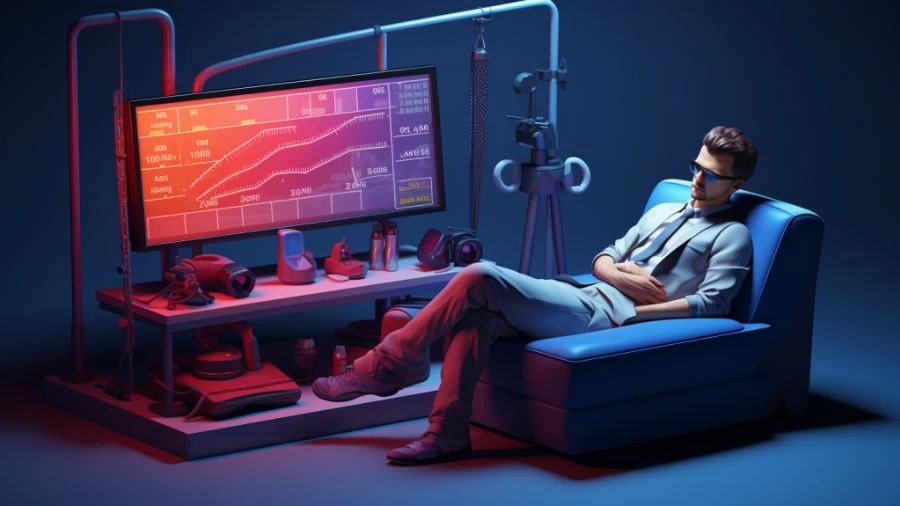
How Do Interest Rates Affect Inflation?
Higher interest rates make it costly to borrow and spend, which can lead to less demand and less inflation. It's like a chain reaction that affects how much things cost in the stores.
Published Sep 29, 2023 | Updated Sep 29, 2023 | 📖 9 min read
On This Page
- How Do Interest Rates Affect Inflation?
- What Is the Relationship Between Inflation and Interest Rates?
- How to Measure Inflation?
- What is the Difference Between Inflation and Deflation?
- How Interest Rates Affect the U.S. Markets?
- What Happens to the Stock Market If Interest Rates Rise?
- Who Benefits from High Interest Rates?
How Do Interest Rates Affect Inflation?
Think of interest rates like the price of borrowing money. When interest rates are high, it becomes more expensive to borrow money. This makes people and businesses think twice before taking out loans or using credit cards because they have to pay more in interest.
When people and businesses borrow less money, they tend to spend less. Imagine you wanted to buy a new car, but the interest rates on car loans were very high. You might decide to wait or buy a cheaper car instead of borrowing a lot of money. This happens on a bigger scale in the whole economy when interest rates are high.
When people and businesses spend less, there's not as much demand for goods and services. When there's less demand, companies might lower their prices to attract customers. This is how higher interest rates can lead to lower inflation. Inflation is when prices in general go up, so if people are spending less and prices aren't going up as much, that's lower inflation.
Additionally, when the central bank (like the Federal Reserve) raises interest rates, it makes it harder for banks to lend money. Banks are less likely to lend because it's more expensive for them to get money from the central bank. This can also reduce the amount of money flowing in the economy, which can help lower inflation.
So,higher interest rates make it more expensive to borrow and spend, which can lead to lower demand and lower inflation.
What Is the Relationship Between Inflation and Interest Rates?
The relationship between inflation and interest rates is a critical aspect of how a country's economy functions. Inflation refers to the increase in the general price level of goods and services over time, while interest rates represent the cost of borrowing money or the return on savings. Inflation and interest rates usually go hand in hand, and here's why:
Federal Reserve's Role: The U.S. central bank, called the Federal Reserve, has a job to keep the economy in good shape. One part of its job is to make sure prices don't rise too quickly (that's inflation) and to help keep people working (that's employment).
Inflation Target: The Federal Reserve aims for an annual inflation rate of around 2%. This means they want prices to go up a little bit every year, but not too fast. It's like a Goldilocks zone for prices.
Interest Rates: To control inflation, the Federal Reserve uses a tool called interest rates. When they want to slow down inflation (if it's rising too fast), they might raise interest rates. This makes it more expensive to borrow money, so people and businesses spend less.
Positive Inflation and Interest Rates: Having some inflation and positive interest rates is a good thing. It gives the Federal Reserve room to help the economy if it's not doing well. If there's no inflation and interest rates are super low or negative, it's harder for the central bank to help when things go wrong.
New Approach: In 2020, the Federal Reserve decided to aim for an average inflation rate. This means if inflation was below 2% for a while, they might try to make it go above 2% for some time to balance it out.
MarketsHost: Your gateway to the dynamic world of finance. Explore, plan, and thrive.
How to Measure Inflation?
To measure inflation, one common way is by using something called the "Personal Consumption Expenditures (PCE) Price Index." This is a tool the Federal Reserve uses to keep an eye on inflation. Here's how it works:
Consumer Spending: Instead of asking people what they buy, like in the Consumer Price Index (CPI), the PCE Price Index looks at how much people are spending on things. It checks the receipts from businesses to figure this out. This helps track what's happening with prices.
Core PCE Price Index: There's also something called the "core PCE Price Index." This one leaves out prices for food and energy because they can bounce around a lot and might not show the overall price trend very well.
What is the Difference Between Inflation and Deflation?
Here's why deflation can be worse than inflation: When prices go down, people might decide to wait to buy things, thinking they'll get an even better deal later. But when people stop buying things, companies make less money, and they might have to lay off workers.
When more people are out of work, they have less money to spend, and the economy can get stuck in a bad cycle. This can lead to a recession, which is when the economy isn't doing well. If things get really bad, it could even lead to a depression, which is a really long and severe economic downturn.
Inflation is when prices for things like goods and services go up over time. So, if a loaf of bread costs $2 this year and $2.10 next year, that's a sign of inflation. Inflation is like a gentle rise in the cost of living.
Deflation, on the other hand, is when prices for things start to go down. If that same loaf of bread now costs $1.90 instead of $2, that's deflation. Deflation might sound good because things are getting cheaper, but it can actually be a big problem.
So, inflation is when prices go up a bit, and deflation is when prices go down. While inflation is generally considered normal, deflation can cause serious economic problems.
How Interest Rates Affect the U.S. Markets?
When interest rates rise, it becomes more expensive to borrow, and this tends to slow down economic activity. When interest rates fall, borrowing gets cheaper, and this can stimulate spending and economic growth. These changes in borrowing costs have a big impact on how the U.S. markets and the overall economy perform.
When Interest Rates Rise
Borrowing Gets Costly: When interest rates go up, it costs more to borrow money. That means if you want to buy a house, get a car loan, or expand your business, it's going to be more expensive because you have to pay more interest.
Spending Slows Down: Because borrowing is pricier, people and businesses tend to spend less. When it costs more to get a loan, you might delay buying that new car or home. This reduction in spending can slow down the overall economy.
When Interest Rates Fall
Borrowing Becomes Cheaper: When interest rates go down, borrowing money becomes cheaper. This encourages people to take out loans because they can get the money at a lower cost.
Boost in Spending: Cheaper borrowing can lead to more spending by consumers and businesses. If it's cheaper to get a mortgage or a business loan, people are more likely to buy homes, invest in their companies, and spend money on big purchases.
What Happens to the Stock Market If Interest Rates Rise?
When interest rates rise, stock prices generally fall because borrowing becomes more expensive for companies, and investors may prefer safer investments like bonds. But it's important to note that not all stocks are affected the same way, and some sectors may actually do better when interest rates go up. When interest rates go up, it can have an impact on the stock market, and here's how it works:
Stock Prices Tend to Fall: Usually, when interest rates rise, stock prices tend to go down. Why? Because higher interest rates make it more expensive for companies to borrow money. When it costs more for them to borrow, they might not have as much money to invest in growing their business. This can make investors less confident, causing stock prices to drop.
Bonds Look More Attractive: When interest rates go up, bonds (which are like loans that people can invest in) become more attractive to investors. This is because bonds offer a guaranteed interest rate, so when market interest rates rise, bonds start to look like a safer bet than stocks.
Impact on Company Profits: Rising interest rates can also affect a company's profitability. If a company has a lot of debt, higher interest rates mean they have to pay more interest on that debt, which can cut into their profits. When investors see that a company's profits might take a hit, they may be less willing to buy its stock, causing the stock price to fall.
Financial Sector Benefits: However, there are some sectors, like banks and financial companies, that tend to benefit when interest rates go up. They can charge more for lending money, so their earnings often go up.
Who Benefits from High Interest Rates?
High-interest rates can benefit certain individuals and sectors in the economy. Here's an explanation of who tends to benefit from high interest rates:
Savers and Investors: People who save money in bank accounts or invest in fixed-income assets like bonds can benefit from high interest rates. When rates are high, they earn more interest on their savings and investments, which can help them grow their wealth over time.
Financial Institutions: Banks and financial institutions tend to benefit from high interest rates. This is because they can charge higher interest rates on loans they provide to borrowers while paying lower interest rates on the deposits they receive from savers. This difference between what they earn and what they pay out, known as the "net interest margin," increases with higher interest rates, boosting their profits.
Real Estate Investors: Real estate, like buying property or commercial buildings, can also be attractive when interest rates are high. High rates can indicate a strong economy, leading to increased demand for real estate. Additionally, rental income from properties can generate higher returns compared to lower-yielding investments during high-rate periods.
Consumer Staples Companies: Companies that produce essential goods and services, such as food, household products, and utilities, often perform well during high-interest-rate periods. These items are necessary for daily life, so their demand tends to remain stable regardless of economic conditions. Such companies typically have reliable cash flows and lower debt levels, making them less sensitive to rising interest rates.
Bond Investors: While it may seem counterintuitive, bond investors can benefit from high interest rates if they hold existing bonds with fixed interest rates. In this case, their bonds become more valuable because they offer higher interest payments compared to new bonds issued at lower rates
How Do Interest Rates Affect Inflation - FAQs
1. Do higher interest rates always lead to lower inflation?
Not always, but they often do because higher interest rates can reduce spending and demand, which can slow down inflation.
2. How can lower interest rates impact inflation?
Lower interest rates can stimulate spending and investment, potentially leading to higher inflation.
3. What's the connection between central banks and inflation through interest rates?
Central banks use interest rates to control inflation; they raise rates to slow inflation and lower rates to boost economic activity.
4. Can inflation occur even when interest rates are low?
Yes, inflation can happen for various reasons, including factors unrelated to interest rates, such as supply shocks.
5. Are there any benefits to moderate inflation?
Yes, moderate inflation can encourage spending and investment, supporting economic growth, but too much inflation can erode purchasing power.




